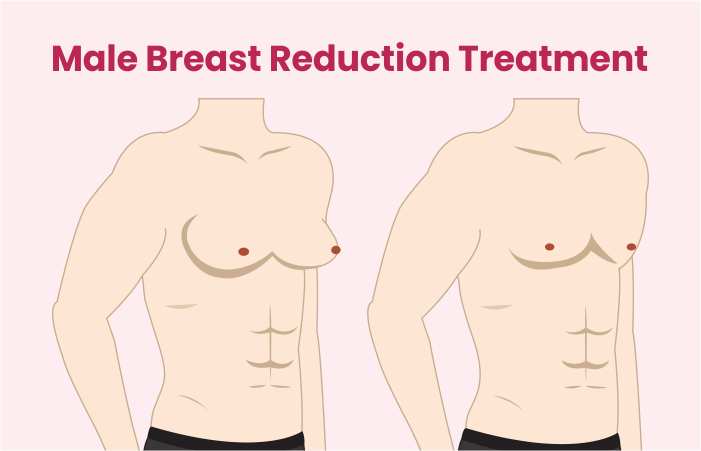Male Breast Reduction Treatment in Hyderabad

What is Male Breast Reduction ?
Are you struggling with enlarged male breasts? Don’t let it affect your self-confidence any longer. Our male breast reduction treatment in Hyderabad offers an effective solution to address gynecomastia and restore a masculine chest contour. With a focus on providing the best treatment for male breast reduction, our dedicated team of experts is committed to helping you achieve the results you desire.

What is Male Breast Reduction Treatment?
Male breast reduction treatment, also known as gynecomastia surgery or male breast reduction surgery, is a cosmetic procedure designed to reduce excess breast tissue in men. It aims to achieve a flatter, more contoured chest appearance, boosting self-esteem and improving body image.
Why is Male Breast Reduction Treatment Performed?
Male breast enlargement, or gynecomastia, can occur due to various factors such as hormonal imbalances, genetics, certain medications, or underlying medical conditions. The condition can cause embarrassment, self-consciousness, and a decline in self-confidence. Our male breast reduction treatment effectively addresses these concerns by removing excess breast tissue, restoring a more masculine chest contour, and improving overall body proportion.
How to Prepare for Male Breast Reduction Treatment
Prior to your male breast reduction procedure, our experienced medical team will guide you through the preparation process. This may involve a comprehensive evaluation of your medical history, physical examination, and any necessary pre-operative tests. You will also receive detailed instructions regarding medication usage, dietary restrictions, and lifestyle adjustments leading up to the surgery.
More about the Procedure and Consequences
During the male breast reduction surgery, our skilled surgeons employ advanced techniques such as liposuction and glandular tissue excision to achieve optimal results. Liposuction helps to remove excess fatty tissue, while glandular tissue excision targets the underlying glandular tissue causing breast enlargement. The procedure is typically performed under general anesthesia and takes into account individual anatomical considerations for precise and natural-looking outcomes.
While every surgical procedure carries potential risks and complications, our highly trained medical professionals prioritize patient safety and take necessary precautions to minimize any adverse effects. We ensure thorough post-operative care, provide comprehensive instructions for a smooth recovery, and schedule follow-up appointments to monitor your progress.
Frequently Asked Questions (FAQs)
Gynecomastia refers to the enlargement of male breast tissue, resulting in a more feminine chest appearance. It can be caused by hormonal imbalances, certain medications, genetics, or underlying medical conditions.
Candidates for male breast reduction treatment typically include individuals who have enlarged male breasts that do not respond to lifestyle changes, such as diet and exercise. Good candidates are generally in good overall health and have realistic expectations about the outcomes of the procedure.
Male breast reduction surgery involves the removal of excess breast tissue through techniques such as liposuction and glandular tissue excision. Liposuction helps remove excess fat, while glandular tissue excision targets the underlying glandular tissue causing the breast enlargement. The specific approach may vary depending on the individual case.
Yes, male breast reduction surgery is typically performed under general anesthesia. This ensures that you are completely asleep and comfortable throughout the procedure.
After the surgery, you may experience some swelling, bruising, and discomfort in the chest area. You will be advised to wear a compression garment to help minimize swelling and support the healing process. The recovery time varies from person to person, but most individuals can return to their regular activities within a few weeks.









